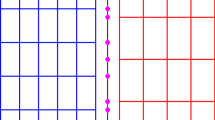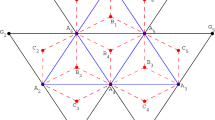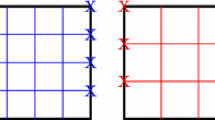Abstract
This work presents an entropy stable discontinuous Galerkin (DG) spectral element approximation for systems of non-linear conservation laws with general geometric (h) and polynomial order (p) non-conforming rectangular meshes. The crux of the proofs presented is that the nodal DG method is constructed with the collocated Legendre–Gauss–Lobatto nodes. This choice ensures that the derivative/mass matrix pair is a summation-by-parts (SBP) operator such that entropy stability proofs from the continuous analysis are discretely mimicked. Special attention is given to the coupling between non-conforming elements as we demonstrate that the standard mortar approach for DG methods does not guarantee entropy stability for non-linear problems, which can lead to instabilities. As such, we describe a precise procedure and modify the mortar method to guarantee entropy stability for general non-linear hyperbolic systems on h / p non-conforming meshes. We verify the high-order accuracy and the entropy conservation/stability of fully non-conforming approximation with numerical examples.










Similar content being viewed by others
References
Bohm, M., Winters, A.R., Derigs, D, Gassner, G.J., Walch, S., Saur, J.: An entropy stable nodal discontinuous Galerkin method for the resistive MHD equations: continuous analysis and GLM divergence cleaning. Comput. Fluids (submitted), ArXiv e-prints: arXiv:1711.05576 (2017)
Bui-Thanh, T., Ghattas, O.: Analysis of an \(hp\)-nonconforming discontinuous Galerkin spectral element method for wave propagation. SIAM J. Numer. Anal. 50(3), 1801–1826 (2012)
Carpenter, M.H., Fisher, T.C., Nielsen, E.J., Frankel, S.H.: Entropy stable spectral collocation schemes for the Navier–Stokes equations: discontinuous interfaces. SIAM J. Sci. Comput. 36(5), B835–B867 (2014)
Carpenter, M.H., Gottlieb, D.: Spectral methods on arbitrary grids. J. Comput. Phys. 129(1), 74–86 (1996)
Carpenter, M.H., Kennedy, C.A.: Fourth-order \(2{N}\)-storage Runge–Kutta schemes. Technical report, NASA Langley Research Center (1994)
Carpenter, M.H., Parsani, M., Nielsen, E.J., Fisher, T.C.: Towards an entropy stable spectral element framework for computational fluid dynamics. In: 54th AIAA Aerospace Sciences Meeting, AIAA, vol. 1058 (2016)
Chandrashekar, P.: Kinetic energy preserving and entropy stable finite volume schemes for compressible Euler and Navier–Stokes equations. Commun. Comput. Phys. 14(5), 1252–1286 (2013)
Chen, T., Shu, C.-W.: Entropy stable wall boundary conditions for the three-dimensional compressible Navier–Stokes equations. J. Comput. Phys. 345, 427–461 (2016)
Del Rey Fernández, D.C., Boom, P.D., Zingg, D.W.: A generalized framework for nodal first derivative summation-by-parts operators. J. Comput. Phys. 266(1), 214–239 (2014)
Evans, L.C.: Partial Differential Equations. American Mathematical Society, New York (2012)
Fisher, T.C., Carpenter, M.H.: High-order entropy stable finite difference schemes for nonlinear conservation laws: finite domains. J. Comput. Phys. 252(1), 518–557 (2013)
Fisher, T.C., Carpenter, M.H., Nordström, J., Yamaleev, N.K.: Discretely conservative finite-difference formulations for nonlinear conservation laws in split form: theory and boundary conditions. J. Comput. Phys. 234(1), 353–375 (2013)
Fjordholm, U.S., Mishra, S., Tadmor, E.: Well-balanced and energy stable schemes for the shallow water equations with discontinuous topography. J. Comput. Phys. 230(14), 5587–5609 (2011)
Friedrich, L., Fernández, D.C.D.R., Winters, A.R., Gassner, G.J., Zingg, D.W., Hicken, J. (2016) Conservative and stable degree preserving SBP finite difference operators for non-conforming meshes. J. Sci. Comput. https://doi.org/10.1007/s10915-017-0563-z (2016)
Gassner, G.J.: A skew-symmetric discontinuous Galerkin spectral element discretization and its relation to SBP-SAT finite difference methods. SIAM J. Sci. Comput. 35(3), A1233–A1253 (2013)
Gassner, G.J., Winters, A.R., Hindenlang, F.J., Kopriva, D.A.: The BR1 scheme is stable for the compressible Navier–Stokes equations. J. Sci. Comput. https://doi.org/10.1007/s10915-018-0702-1 (2018)
Gassner, G.J., Winters, A.R., Kopriva, D.A.: Split form nodal discontinuous Galerkin schemes with summation-by-parts property for the compressible Euler equations. J. Comput. Phys. 327, 39–66 (2016)
Hindenlang, F., Gassner, G.J., Altmann, C., Beck, A., Staudenmaier, M., Munz, C.-D.: Explicit discontinuous Galerkin methods for unsteady problems. Comput. Fluids 61, 86–93 (2012)
Ismail, F., Roe, P.L.: Affordable, entropy-consistent Euler flux functions II: entropy production at shocks. J. Comput. Phys. 228, 5410–5436 (2009)
Kopriva, D.A.: A conservative staggered-grid Chebyshev multidomain method for compressible flows. II. A semi-strictured method. J. Comput. Phys. 128(2), 475–488 (1996)
Kopriva, D.A.: Implementing Spectral Methods for Partial Differential Equations. Scientific Computation. Springer, Berlin (2009)
Kopriva, D.A., Woodruff, S.L., Hussaini, M.Y.: Computation of electomagnetic scattering with a non-conforming discontinuous spectral element method. Int. J. Numer. Meth. Eng. 53(1), 105–122 (2002)
Kozdon, J.E., Wilcox, L.C.: Stable coupling of nonconforming, high-order finite difference methods. SIAM J. Sci. Comput. 3(38), A923–A952 (2016)
Mattsson, K., Carpenter, M.H.: Stable and accurate interpolation operators for high-order multiblock finite difference methods. SIAM J. Sci. Comput. 32(4), 2298–2320 (2010)
Nordström, J., Lundquist, T.: On the suboptimal accuracy of summation-by-parts schemes with non-conforming block interfaces. Technical report, Linköpings Universitet (2015)
Parsani, M., Carpenter, M.H., Fisher, T.C., Nielsen, E.J.: Entropy stable staggered grid discontinuous spectral collocation methods of any order for the compressible Navier–Stokes equations. SIAM J. Sci. Comput. 38(5), A3129–A3162 (2016)
Parsani, M., Carpenter, M.H., Nielsen, E.J.: Entropy stable discontinuous interfaces coupling for the three-dimensional compressible Navier–Stokes equations. J. Comput. Phys. 290(C), 132–138 (2015)
Ray, D., Chandrashekar, P.: An entropy stable finite volume scheme for the two dimensional Navier–Stokes equations on triangular grids. Appl. Math. Comput. 314, 257–286 (2017)
Sjögreen, B., Yee, H.C., Kotov, D.: Skew-symmetric splitting and stability of high order central schemes. In: Journal of Physics: Conference Series, vol. 837, p. 012019 (2017)
Tadmor, E.: Skew-selfadjoint form for systems of conservation laws. J. Math. Anal. Appl. 103(2), 428–442 (1984)
Tadmor, E.: Entropy functions for symmetric systems of conservation laws. J. Math. Anal. Appl. 122(2), 355–359 (1987)
Tadmor, E.: Entropy stability theory for difference approximations of nonlinear conservation laws and related time-dependent problems. Acta Numer. 12, 451–512 (2003)
Wintermeyer, N., Winters, A.R., Gassner, G.J., Kopriva, D.A.: An entropy stable nodal discontinuous Galerkin method for the two dimensional shallow water equations on unstructured curvilinear meshes with discontinuous bathymetry. J. Comput. Phys. 340, 200–242 (2017)
Winters, A.R., Moura, R.C., Mengaldo, G., Gassner, G.J., Walch, S., Peiro, J., Sherwin, S.J.: A comparative study on polynomial dealiasing and split form discontinuous Galerkin schemes for under-resolved turbulence computations. J. Comput. Phys. (submitted), ArXiv e-prints arXiv:1711.10180 (2017)
Acknowledgements
Lucas Friedrich and Andrew Winters were funded by the Deutsche Forschungsgemeinschaft (DFG) Grant TA 2160/1-1. Special thanks goes to the Albertus Magnus Graduate Center (AMGC) of the University of Cologne for funding Lucas Friedrich’s visit to the National Institute of Aerospace, Hampton, VA, USA. Gregor Gassner has been supported by the European Research Council (ERC) under the European Union’s Eights Framework Program Horizon 2020 with the research project Extreme, ERC grant agreement no. 714487. This work was partially performed on the Cologne High Efficiency Operating Platform for Sciences (CHEOPS) at the Regionales Rechenzentrum Köln (RRZK) at the University of Cologne.
Author information
Authors and Affiliations
Corresponding author
Appendices
A Derivations of the Growth of Primary Quantities and Entropy
The proof below is the same result as presented by Fisher et al. [12]. For completeness, we re-derive the proof in our notation. We analyze the two dimensional discretization of (1.27) on a single element.
with
Assuming, that \(\tilde{\varvec{F}}^{\mathrm {EC}}\) and \(\tilde{\varvec{G}}^{\mathrm {EC}}\) satisfy the appropriate entropy condition (1.24)
First, we derive the growth of the primary quantities on each element \(E_k, k=1,\ldots ,K\). Summing over all nodes \(i,j=0,\ldots ,N\) yields
with
Using the SBP property of the matrices \(2{\mathsf {Q}}={\mathsf {Q}}-{\mathsf {Q}}^T+{\mathsf {B}}\) we find
Due to nearly skew-symmetric nature of \({\mathsf {Q}}\) we arrive at
And similar for \(\sum \limits _{j=0}^N\mathcal {L}(\varvec{U}_{ij})_y\) we have
Together both directions yield
which is precisely (2.5).
Next, we derive the entropy growth on the single element. To do so, we pre-multiply with the entropy variables and sum over all nodes to get
with
Again using \(2{\mathsf {Q}}={\mathsf {Q}}-{\mathsf {Q}}^T+{\mathsf {B}}\) we have
Due to entropy conservation condition (1.24) and the consistency of the derivative matrix, i.e. \(\mathsf {D}\varvec{1}=\varvec{0}~\left( \Leftrightarrow {\mathsf {Q}}\varvec{1}=\varvec{0}\right) \) we find
And similar for \(\sum \limits _{j=0}^N\varvec{V}_{ij}^T\mathcal {L}(\varvec{U}_{ij})_y\) we get
Both directions together yield
which is precisely (2.6).
B Projection Operators for Discontinuous Galerkin Methods
The projection operators for DG methods are constructed with the Mortar Element Method by Kopriva [22].
Here we assume two neighboring elements with a single coinciding interface as in Fig. 5. Let N, M denote the polynomial degrees of both elements with corresponding one-dimensional nodes \(x_0^N,\ldots ,x_N^N\) and \(x_0^M,\ldots ,x_M^M\) and integration weights \(\omega _0^N,\ldots ,\omega _N^N\) and \(\omega _0^M,\ldots ,\omega _M^M\). The corresponding norm matrices are defined as \(\mathsf {M}_N={{\mathrm{diag}}}(\omega _0^N,\ldots ,\omega _N^N)\) and \(\mathsf {M}_M={{\mathrm{diag}}}(\omega _0^M,\ldots ,\omega _M^M)\) and each element is equipped with a set of Lagrange basis functions \(l_0^N,\ldots ,l_N^N\) and \(l_0^M,\ldots ,l_M^M\).
As for the elements, the mortar also consists of a set of nodes, integration weights, norm matrix and Lagrange basis functions. Without lose of generality, we assume \(N<M\). Therefore, the polynomial order on the mortar \(N_{\varXi } = \max \{N,M\} = M\). So the mortar will simply copy the solution data from the element with the higher polynomial degree M because the nodal distributions are identical. Thus, the projection operator from the element to the mortar as well as back from the mortar to the element are simply the identity matrix of size M, i.e. \({\mathsf {P}}_{M2\varXi }={\mathsf {I}}^M\) and \({\mathsf {P}}_{\varXi 2M}={\mathsf {I}}^M\). Next, we briefly describe how to project the element of degree N to the mortar and back.
Step 1 (Projection from element of degree N to the mortar) Assume we have a discrete evaluated function \(\varvec{f}=(f_0,\ldots ,f_N)^T\) with \(f(x)=\sum _{i=0}^N\ell _i^N(x)f_i\). We want to project this function onto the mortar to obtain \(\varvec{f}^{\varXi }=(f^{\varXi }_0,\ldots , f^{\varXi }_{M})^T\) with \( f^{\varXi }(x)=\sum _{j=0}^{M}\ell _j^M(x) f^{\varXi }_j\). Note, that \({f}(x)\ne {f}^\varXi (x)\) for a polynomial of higher degree. In [22] the operator \(P_{N2\varXi }\) is created by a \(L_2\) projection on the mortar
for \(j=0,\ldots ,M\). Here, the \(L_2\) inner products are evaluated discretely using the appropriate norm matrices. The \(L_2\) inner product on the left in (B.1) is evaluated exactly due to the high-order nature of the LGL quadrature and the assumption that \(N<M\). Therefore, using M-LGL nodes and weights we have
for \(i=0,\ldots ,N\), \(j=0,\ldots ,M\) and use the Kronecker delta property of the Lagrange basis. On the right side of (B.1) we evaluate an inner product of two polynomial basis functions of order M. Therefore, due to the exactness of the LGL quadrature, the \(L_2\) inner product is approximated by an integration rule with mass lumping, e.g. [2],
for \(i,j=0,\ldots ,M\). Next, we define interpolation operators
with \(i=0,\ldots ,N\) and \(j=0,\ldots ,M\) to rewrite (B.1) in a compact matrix-vector notation
So the projection operator to move the solution from the element with N nodes onto the mortar is equivalent to an interpolation operator. However, this does not hold for projecting the solution from the mortar back to the element.
Step 2 (Projection from the mortar to element of degree N) To construct the operator \({\mathsf {P}}_{\varXi 2N}\) we consider the \(L_2\) projection from the mortar back to an element with N nodes. Here, we assume a discrete evaluation of the solution on the mortar \(\varvec{f}^\varXi =(f_0^\varXi ,\ldots ,f_M^\varXi )^T\) with \(f^\varXi (x)=\sum _{i=0}^M \ell _i^M(x)f_i^\varXi \) and seek the solution on the element \(\varvec{f}=( f_0,\ldots , f_N)^T\) with \( f(x)=\sum _{i=0}^N \ell _i^N(x) f_i\). The \(L_2\) projection back to the element is
for \(j=0,\ldots ,N\). The \(L_2\) inner product on the left in (B.6) is computed exactly using M-LGL points and the \(L_2\) inner product on the right in (B.6) is approximated with mass lumping at N-LGL nodes. Thus, we obtain
where \(i=0,\ldots ,M\), \(j = 0,\ldots ,N\) and
for \(i,j=0,\ldots ,N\). Again, we write (B.6) in a compact matrix-vector notation which gives us
As \({\mathsf {L}}_{N2\varXi }={\mathsf {P}}_{N2\varXi }\) we obtain
where we introduce the projection operator (not interpolation operator) from the mortar back to the element with N nodes. With this approach we constructed projection operators satisfying the \(\mathsf {M}\)-compatibility condition (2.24), i.e.,
By combining the operators, we can construct projections which directly move the solution from one element to another (in some sense “hiding” the mortar) to be
Note, that in this paper we only consider LGL-nodes for the approximating the \(L_2\)-projection. However, the approach in [22] is more general as it also considers Legendre Gauss nodes and the construction of projection operators on interfaces with hanging corners.
C Experimental Order of Convergence–Degree Preserving Element Based Finite Difference Operators
Besides Discontinuous Galerkin SBP operators, we analyze the convergence of degree preserving, element based finite difference operators (DPEBFD) operators. As described in [14] these operators are SBP operators by construction, for which our entropy stable discretization remains stable. The norm matrix of the DPEBFD operator integrates polynomials up to degree of \(2p+1\) exactly, where p denotes the minimum polynomial degree of all elements. In comparison to SBP finite difference operators as in [9] these operators are element based, meaning that the number of nodes is fixed as for DG operators.
As we focus on elements with SBP operators of the same degree, we set all elements to be DPEBFD elements with degree p where \(p=2,3\). To approximate the convergence order of the non-conforming discretization, we consider the same mesh refinement strategy as in Fig. 7 with element types A, B, B. These types are set up in the following way:
-
Element A with 22 nodes in x- and y-direction,
-
Element B with 24 nodes in x- and y-direction,
-
Element C with 22 nodes in x- and y-direction.
This leads to a mesh considering h / p refinement. Here, we obtain the results in Tables 5, 6.
As documented in [14] we numerically verify an EOC of \(p+1\). So when considering degree preserving SBP operators our entropy stable non-conforming method can handle h / p refinement and possesses full order. However when considering DG-operators we obtain a smaller \(L_2\) error for a more coarse mesh. We do not claim that DPEBFD operators have the best error properties, but considering these operators is a possible cure for retaining a full order scheme. The development of optimal degree preserving SBP operators is left for future work.
Rights and permissions
About this article
Cite this article
Friedrich, L., Winters, A.R., Del Rey Fernández, D.C. et al. An Entropy Stable h / p Non-Conforming Discontinuous Galerkin Method with the Summation-by-Parts Property. J Sci Comput 77, 689–725 (2018). https://doi.org/10.1007/s10915-018-0733-7
Received:
Revised:
Accepted:
Published:
Issue Date:
DOI: https://doi.org/10.1007/s10915-018-0733-7




